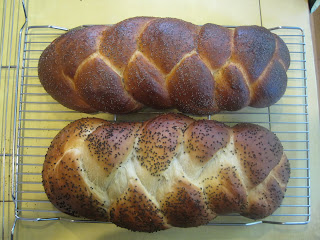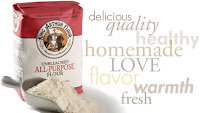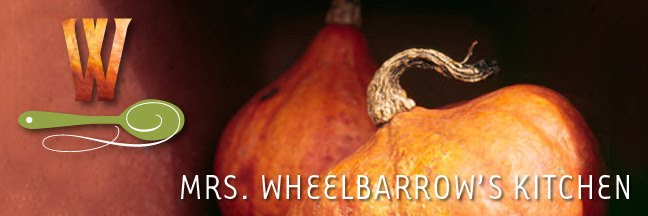
Today the website for Wooden Spoon Classes launched. It's very exciting. Click
here to check it all out. I'm very pleased with the whole thing and thank Liz from
Design291 for all her hard work.
It's a new direction for Mrs. Wheelbarrow, and appropriately enough, just recently, we celebrated the Jewish New Year. In honor of the holiday, and new beginnings, I baked two loaves of challah. This was the first bread I ever taught myself to make, and after 20 some odd years of baking and braiding, I've gotten this recipe down to a science. It came from my great grandmother, Agatha, although I don't remember ever actually seeing her make it.

Challah is a traditional food for Sabbath dinners, and often for the New Year, it's braided form is presented as a round braided loaf to represented the circle of life. Isn't that nice? I've tried to make a braided circle and never could get it to work out. I think making bread is representative enough.

This seems like a good time to talk about flours. I've been experimenting in all my bread baking (including foccacia, pizza dough, and sandwich loaves) with two flours from King Arthur - the
Artisan and the
Sir Lancelot. I was curious to see if a change in flour was appreciable, since shipping it in goes against all my green leanings.
I am here to report - I really like the Artisan flour! It makes an exceptional crispy pizza crust. Better than regular King Arthur white flour? Well, yes. I'm glad I have an extra 3# bag in the pantry, and when I need another package of
pre-cut parchment sheets (the very best thing in the baking world,) I'm sure I'll order another bag or two.
Not so much for the Sir Lancelot. The flour even felt light and fluffy to the touch, but the resulting dough was too light and there wasn't much of a crust. The blurb about the flour says it will make European style crusty breads and my experience was exactly the opposite.
But - back to the Challah. This is an eggy bread, so use nice fresh eggs. (I've made it with duck eggs and that is just amazingly yellow and rich!) This is a holiday bread, and the fact that it makes two loaves is the best part. That extra loaf in my freezer will be pulled out at Thanksgiving for sandwiches. Or New Year's Day bread pudding.
This recipe makes two very large loaves. I often slice it and freeze the slices. I've also made four small loaves. Start to finish, it's a five hour process. But there is plenty of down time. And you can always put the dough in the fridge to rise overnight, too.

Challah
makes two large loaves
Equipment
a stand mixer is really nice, but you can make these loaves by hand
a large rising bowl, oiled
bench scraper
two sheet pans, lined with parchment, brushed with oil and dusted with cornmeal
Sponge
2 tsp sugar
1 Tbls flour
1 c/ 8 oz warm water (110•F = hot from the faucet)
5 tsp yeast (two packages)
Warm a large bowl, or the bowl of your stand mixer by running hot water into it. Whisk all the sponge ingredients together. Cover the bowl with a clean dish towel and let it bubble away for about 10 minutes, while you get the rest of the ingredients together. (If, after 10 minutes, you don't have any foaming, your yeast may not be fresh. Start again with fresh yeast. Keep your yeast in the freezer if you don't use it frequently!)
Bread
1.5/12 oz c warm water
3 whole large eggs
2 egg large yolks
1/2 c/4 oz canola oil (or peanut)
1/2 c/95 gr Sugar
2 Tbls Kosher Salt
1/4 c/2oz light colored honey, I like to use clover, wildflower or apple blossom
7-8 c/700-800gr flour
Egg Wash
1 egg yolk
1 T sugar
poppy seeds (or my favorite, and what Agatha's recipe called for, charnushka seed from
Penzeys)
If you are using the stand mixer, get the paddle attachment going at a nice slow pace, and add to the sponge, the eggs and egg yolks, the oil, sugar, salt and honey, and warm water. Scrape the bowl and add about 2.5 c of the flour and mix and scrape the bowl again. Mix for about five minutes at a medium speed.
Add four cups of flour. Stir it up with a wooden spoon or a spatula. Don't worry if it's all shaggy. Now, walk away from the dough. Take a 10 minute break. Check your email. Make a cup of tea. When you come back, the flour will have absorbed the liquid and it will be much easier to work with.
Switch to the dough hook. (Or roll up your sleeves.) Let the hook work on the dough for about 10 minutes. The dough will be nice and elastic, and will have a few little bubbles on the surface. It will be very soft.
Flour your counter lightly, turn out the dough and give it a little bit of a knead. Be gentle with it. Push it away, and use the bench scraper to lift and turn. It's a very delicate dough and the bread will have a better crumb if you use a light touch.
Tip the dough into the oiled bowl, cover it with a tea towel and let it rise in a warm place for 2 hours, or until doubled.
When it's all puffy and fabulous, gently deflate the dough (do not punch it down... that's not nice), and then let it rise again for 45 minutes.
Now it's time to braid your loaves. Tip the dough out of the bowl onto a lightly floured surface and divide into two parts. Then divide each half into three parts. Roll each part into a length about 12" long.
Line the three ropes up side by side. Start in the middle, braid to the end, then braid the other half. (here's a
link to a way-too-long You Tube video showing you how.) Tuck the ends under and pinch them together. There are a number of other braids - a four-rope braid and a six-rope braid. I can just manage the three strand, but that's just me.
Carefully lift the loaf and place it on the sheet pan. Repeat with the second loaf.
Brush the loaves with the egg wash, . Sprinkle generously with the seeds. Let the loaves rise, uncovered, for about 30 minutes.
Preheat the oven to 375•F/190C.
Bake the loaves for 40 minutes, switching their positions halfway through. Check to make sure they're not browning too quickly, and if they are, tent with foil. When the loaf is finished, a thermometer inserted will measure an internal temp of 190.
Pull the loaves out of the oven and cool on a rack.










Comments(0)